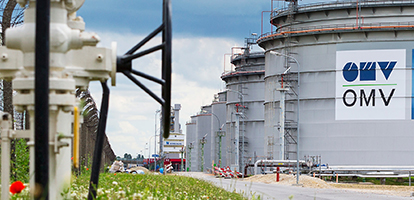


The Viennese energy supplier, VERBUND Solutions GmbH, combines decentralized electrical producers and consumers for marketing to the balancing energy market in their virtual power plant, the VERBUND Power Pool. One of these decentralized producers is OMV, an integrated oil and gas company. The exchange of process data is carried out using telecontrol technology from WAGO.
Providing electricity is a complex business that presents technical and logistical challenges to power suppliers, because production and consumption must be constantly maintained in balance so that the electrical supply system does not tip into failure. Electrical companies therefore have to ensure that there is always sufficient electricity in the system and that the network remains stable, despite fluctuating and unpredictable consumption.
There are national balancing energy markets to guarantee a constant frequency of 50 Hz in the electrical network, which can fluctuate during supply peaks or outages at power plants. Balancing energy represents a type of energy reserve that can be physically tapped for the short term and thus prevents a collapse of the electrical network by stabilizing the frequency back to 50 Hz. Austria defines primary, secondary, and tertiary balancing reserves according to whether the required energy is to be provided by the producer within a few seconds, or within five or ten minutes.
Pan-European Balancing Energy Market
In addition to classic power generators, the balancing energy market enables loads and consumers in industrial fields the opportunity to maintain stability in the electrical system through reductions/increases in electrical production and activation/deactivation of loads, following successful prequalification. In Austria, the oil and gas company OMV used this chance and prequalified as a supplier of tertiary balancing energy three years ago.
“We operate two combined heat and power plants at our refinery in Vienna-Schwechat, which supply the entire petrochemical facility with electricity. We combust unusable residues from gasoline and diesel production, natural gas, residual gas, and mixed gas,” explains Alexander Radauer, Procurist for Operations for the OMV refinery in Schwechat, and adds, “the capacity of our CHPs essentially functions to cover our own use. The production by products that we convert to electricity do not accumulate predictably, and can only be provisionally stored. The opening of the balancing energy market for industrial systems offered us the possibility of selling our excess electricity.”
After a year of collaboration with the Slovenian energy supplier, GEN-I, OMV now cooperates with VERBUND Solutions GmbH in the context of the VERBUND Power Pool. If excess capacity is present, the oil and gas company can activate up to 15 megawatts for the short-term balancing reserve. Radauer explains, “We only provide the asset. Selling to the balancing energy market is carried out by the Power Pool.”
OMV’s asset is one of many that feed current into the electrical network during frequency fluctuations, or draw down during excesses. To simplify marketing of both decentralized electrical producers and consumers, VERBUND Solutions combines the decentralized energy systems and consumers into so-called virtual power plants. “As a balancing reserve supplier, this has many advantages for us: we can collect decentralized producers and consumers into an aggregated whole in one virtual power plant. Then, we can sell the bundled, individual participants to the balancing energy market,” explains Bertram Weiss, Product Manager at VERBUND Solutions.
Control Box as System Core
A control box, located in the respective power plant, functions as a communication interface between producers, consumers, and retailers. The core is a WAGO PFC200 Controller. “At a command from the virtual power plant, the WAGO controller collects the desired power plant data, such as deliverability status and available output, and returns this information in bundled form. In the reverse direction, the PFC200 accepts commands for output provision and transmits them to the control center of the CHP. “Power plant specific interfaces originally consisted of several digital and analog signals. After modifications, the information is currently transmitted using serial two-wire bussystems, Modbus RTU,” explains Martin Kluchert from WAGO.
The communication between the virtual power plant and the WAGO controller is carried out using a fixed telephone network and is encrypted via a VPN tunnel. In the case of the OMV-VERBUND cooperation, the oil and gas company transmits around 25 data points to the network operator, who returns around ten data points to their decentralized electrical suppliers. The WAGO controller converts commands and information to Modbus RTU in order to communicate with the process command system at OMV. “The process command system reports the query to the power plant operator, both on a user interface and with an acoustic signal, at which point the operator supplies excess capacity to the network by manually spinning up the turbines. OMV, as a supplier of tertiary balancing energy, is obligated to achieve the target value within ten minutes,” explains Bernhard Vogel. He maintains the CHP control technology at the OMV refinery in Schwechat. A direct and automated access via the control box into the power plant controller is not necessary, due to the long run-up time; however, one is planned for their future entry into providing primary reserves, for which the runup time is a few seconds.
“The high operational reliability, ease of operation, expandability, and the multitude of supported interfaces all support choosing WAGO controllers,” says Jakob Fölser, the contact person for technical connections in virtual power plants at VERBUND Solutions. He adds, “the pre-assembled control boxes allow us to expand a virtual power plant at any time, and without programming expenses for the decentralized energy suppliers. This helps to save time and money.”
Communication Interface Controller
“Small, decentralized power plants often lack uniform controllers, and instead have hardware inputs and outputs. Thus, for example, digital outputs report operating states, like faults, maintenance, or availability. Analog signals are used to exchange currently available outputs, or requested outputs. However, bussystems, like MODBUS or PROFIBUS are also commonly found,” states Kluchert from WAGO. The WAGO controller establishes communication interfaces between interfaces specific to a power plant, and the control system for the virtual power plant. The connection to the network operator is then carried out using various standardized telecontrol protocols. In Europe, this is usually IEC 60870 or IEC 61850, depending on system type.
also included with the WAGO controllers. This new industry standard, introduced by WAGO, defines operating conditions, operating properties, and data points so precisely that any system can be integrated into a VHPready network without additional software programming. “Security technology, from firewalls to VPN clients, is integrated into the controllers to help protect critical infrastructures. And the linking of small, remote power plants into one virtual power plant is quite simple using the integrated GSM modem,” adds Kluchert.
VERBUND Solutions already uses the VHPready standard in additional control boxes, and thus connects several small power plants into its virtual power plant. WAGO offers a complete, yet expandable application for this, which enables VERBUND Solutions to quickly and flexibly link power plants using graphic-supported configuration, and to consider individual desires while doing so. The modular WAGO-I/O-SYSTEM, which is provided in pre-wired boxes, also supports this process and secures a long system availability due to its extreme robustness.
Text: MARTIN KLUCHERT, WAGO
Photos: OMV